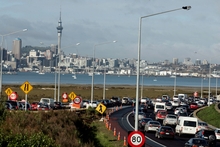Northern Pass tickets introduced in 2008 to kick-start bus patronage are doomed, as are Discovery Passes. Photo / APN
Auckland Transport intends ditching discount travel passes while extending the $100 million Hop ticketing system to buses.The move, potentially affecting thousands of commuters and day-trippers, could almost treble the cost of some multi-stage journeys.
Discovery Passes giving Aucklanders and tourists unlimited daily travel for $16 on buses, trains and some ferries will be among casualties of a drive to co-ordinate prices across transport operators.
Also doomed are Northern Pass tickets introduced among three bus companies in 2008 to kick-start patronage of the $300 million Northern Busway. Those were to encourage use of feeder buses to the busway through two-hour, daily and weekly discount travel, including return trips from upper North Shore suburbs such as Torbay to Britomart or Newmarket and back now costing just $5.90 if taken within the shorter time limit.
That could almost treble to $17.40 for passengers resorting to cash fares to travel to Newmarket and back, although Hop card users can expect 10 per cent discounts.
Auckland Transport has confirmed - through a previously confidential paper issued to the Herald - intending to axe most discount fares during the Hop rollout to buses, which it expects to complete by the end of the year.
"While a significant communications campaign will be undertaken, some of these changes may attract some criticism initially as AT transitions to the integrated ticketing simpler product suite," the paper warned the council agency's board in March.
The agency has begun introducing a three-tiered monthly pass system common to all bus and rail operators, costing $140, $190 or $250 depending on distance travelled. These will be the only alternatives to single-trip fares. Although adults now travelling from the upper North Shore on seven-day Northern Pass tickets could save $16 by swapping to $190 monthly passes, those from south of Constellation Drive face a $28 rise.
Students and the disabled face steeper rises, of $58 a month from north of Constellation Drive and $90 from the lower North Shore.
Urban Express bus passengers have already been hit with a 90 per cent monthly fare increase for travel between Green Bay and Onehunga, and Auckland Transport has quietly raised single-zone rail passes by 16.7 per cent.
One woman who works in the CBD, who asked not to be named, said the fare increase would drive her to add to the congestion and drive in. She mostly buys a seven-day pass from the lower North Shore to Britomart, meaning she could see a $28 rise for a $190 monthly pass.
"It's just too expensive - for that much a month I could drive in and pay for parking with change left over. That rise will just make more people use their cars and add to the traffic and pollution problems."
University of Auckland student Man Jun pays $33 for a student weekly pass between upper North Shore and the CBD. He believes that is already "expensive enough".
Despite the March report's promise to raise public awareness before axing discount tickets, it took an industry source to alert the Herald to the plan. He expects the Northern Pass to be gone by late September, when busway operator Ritchies becomes the last of the three Northern Pass companies to join Hop, after Birkenhead Transport and NZ Bus subsidiary North Star.
The source, who became alarmed about the changes while working on the rollout, fears a serious dent in patronage under an integrated ticketing scheme which was supposed to attract more Aucklanders to public transport.
Auckland Transport chairman Lester Levy repeated the promise of a sweeping review of all public transport fares to ensure "attractive and affordable pricing" to entice more people from their cars.
His organisation has meanwhile failed to respond to Herald requests for more information, including the number of passengers travelling on discount passes.
- additional reporting Amelia Wade








